Latitudes 1 Samenvattingen, Notities en Examens
Op zoek naar een samenvatting over Latitudes 1? Op deze pagina vind je 366 samenvattingen over Latitudes 1.
Pagina 2 van de 366 resultaten
Sorteer op
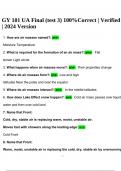
-
GY 101 UA Final (test 3) 100%Correct | Verified | 2024 Version.
- Tentamen (uitwerkingen) • 8 pagina's • 2024
-
- $11.99
- + meer info
GY 101 UA Final (test 3) 100%Correct | Verified | 2024 Version. 1. How are air masses named?: ansMoisture Temperature 2. What is required for the formation of an air mass?: ans- Flat terrain Light winds 3. What happens when air masses move?: ans- Their properties change 4. Where do air masses form?: ans- Low and high latitudes Near the poles and near the equator 5. Where do air masses interact?: ans- In the middle latitudes 6. How does Lake Effect snow happen?: ans- Cold air mass passes ...

-
Oceanography Test 2 SDSU Latest Update with Verified Solutions
- Tentamen (uitwerkingen) • 14 pagina's • 2024
- Ook in voordeelbundel
-
- $9.99
- + meer info
Oceanography Test 2 SDSU Latest Update with Verified Solutions water molecule (basic atomic structure) 1 oxygen (negative); 2 hydrogen (positive) Hydrogen bond: inter-molecular bonds (bond water molecules together) Polarity Water is a polar molecule; electromagnetic H end: partial (+) charge, attracts (-) O end: partial (-) charge, attracts (+) thus, dissolves substances (universal solvent) 3 phases of water solid (ice) liquid (water) gas (vapor) In order to make water change ph...
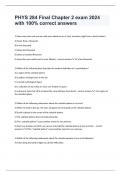
-
PHYS 284 Final Chapter 2 exam 2024 with 100% correct answers
- Tentamen (uitwerkingen) • 27 pagina's • 2024
-
- $16.49
- + meer info
1) How many stars can you see with your naked eye on a clear, moonless night from a dark location? A) fewer than a thousand B) a few thousand C) about ten thousand D) about a hundred thousand E) more than you could count in your lifetime - correct answer B) a few thousand 2) Which of the following best describes the modern definition of a constellation? A) a region of the celestial sphere B) a pattern of bright stars in the sky C) a Greek mythological figure D) a collection of stars ...
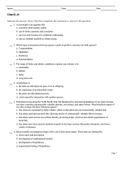
-
Test Bank for Ecology: The Economy of Nature 9th Edition by Rick Relyea
- Tentamen (uitwerkingen) • 443 pagina's • 2023
-
- $45.49
- 7x verkocht
- + meer info
Test bank for Ecology: The Economy of Nature 9e 9th Edition by Rick Relyea. ISBN-13: 5542 Full Chapters test bank included Chapter 1 An Introduction to Ecology 1.1 Ecological Systems Exist in A Hierarchy of Organization Individuals Populations Communities Ecosystems The Landscape The Biosphere 1.2 Physical and Biological Principles Govern Ecological Systems Conservation of Matter and Energy Dynamic Steady States Evolution 1.3 Different Organisms Play Diverse Roles in Ecological...
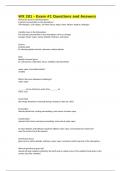
-
WX 201 - Exam #1 Questions and Answers
- Tentamen (uitwerkingen) • 15 pagina's • 2024
-
- $10.89
- + meer info
WX 201 - Exam #1 Questions and Answers Permanent Gases in the Atmosphere Constant concentration in the atmosphere 78% Nitrogen, 21% Oxygen, 1% Other Gases: Argon, Neon, Helium, Krypton, Hydrogen Variable Gases in the Atmosphere The amount/concentration in the atmosphere varies or changes Includes: Water Vapor, Carbon Dioxide, Methane, and Ozone Sources produce gases Ex: decaying plants/animals, volcanoes, photosynthesis Sinks deplete (remove) gases Ex: soil bacteria, resp...
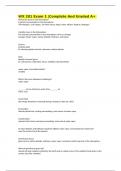
-
WX 201 Exam 1 |Complete And Graded A+
- Tentamen (uitwerkingen) • 15 pagina's • 2024
-
- $10.89
- + meer info
WX 201 Exam 1 |Complete And Graded A+ Permanent Gases in the Atmosphere Constant concentration in the atmosphere 78% Nitrogen, 21% Oxygen, 1% Other Gases: Argon, Neon, Helium, Krypton, Hydrogen Variable Gases in the Atmosphere The amount/concentration in the atmosphere varies or changes Includes: Water Vapor, Carbon Dioxide, Methane, and Ozone Sources produce gases Ex: decaying plants/animals, volcanoes, photosynthesis Sinks deplete (remove) gases Ex: soil bacteria, resp...

-
Aviation Weather Questions and Answers Graded A+
- Tentamen (uitwerkingen) • 15 pagina's • 2024
- Ook in voordeelbundel
-
- $9.99
- + meer info
Aviation Weather Questions and Answers Graded A+ Select all characteristics that help define an airmass. Uniform moisture content Uniform Stability Uniform temperature If an airmass is colder then the ground it is moving over it is a classified as a ______________ cold airmass A maritime tropical airmass generally was what characteristics? Warm temperature, high moisture content, high dew point Typically, an advancing cold airmass has what kind of front on the leading edge? Co...

-
SARAH Michelle crash course With Questions and Correct Answers 2024.
- Tentamen (uitwerkingen) • 31 pagina's • 2024
-
- $15.99
- + meer info
SARAH Michelle crash course With Questions and Correct Answers 2024. Biome - -A large region characterized by a specific type of climate and certain types of plant and animal communities. 1. Savanna - -A tropical / subtropical grassland biome with scattered individual trees, large herbivores, and three distinct seasons based primarily on rainfall, maintained by occasional fires and drought. 2. Desert - -A region of little vegetation, either cold or hot, that receives ten inches or le...

-
ERSC 180 W1 Quiz Questions and Answers | Latest 2023/2024 (Graded A+) .
- Tentamen (uitwerkingen) • 19 pagina's • 2024
-
- $8.49
- + meer info
Week 1 Quiz Return to Assessment List Part 1 of 4 - Week 1 Quiz: Part I - Textbook Reading 72.0/ 72.0 Points Question 1 of 33 3.0/ 3.0 Points How does the size of anthropogenic aerosols compare with natural aerosols? • A. Anthropogenic aerosols are considerably larger than natural aerosols. • B. Anthropogenic aerosols are slightly larger than natural aerosols. • C. Anthropogenic aerosols are considerably smaller than natural aerosols. • D. Anthropogenic aerosols are slightly...

-
W1 Quiz Questions and Answers | Latest 2023/2024 (Graded A+).
- Tentamen (uitwerkingen) • 23 pagina's • 2024
-
- $8.49
- + meer info
Week 1 Quiz Return to Assessment List Part 1 of 4 - Week 1 Quiz: Part I - Textbook Reading 72.0/ 72.0 Points Question 1 of 33 3.0/ 3.0 Points How does the size of anthropogenic aerosols compare with natural aerosols? A. Anthropogenic aerosols are considerably larger than natural aerosols. B. Anthropogenic aerosols are slightly larger than natural aerosols. C. Anthropogenic aerosols are considerably smaller than natural aerosols. D. Anthropogenic aerosols are slightly...

Studiestress? Voor verkopers op Stuvia zijn dit juist gouden tijden. KA-CHING! Verdien ook aan je samenvattingen en begin nu met uploaden. Ontdek alles over verdienen op Stuvia


